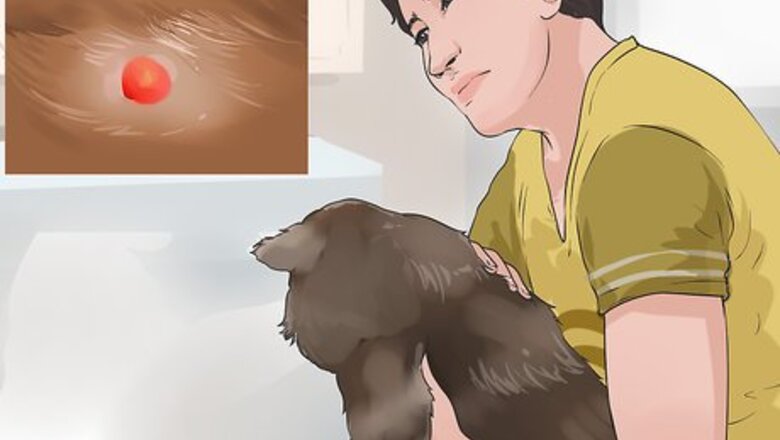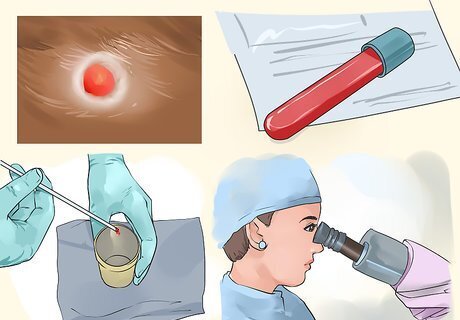
views
Identifying Blood Blisters

Look for a bump. The single most noticeable symptom of blood blisters is bumps that appear just below the skin. If you notice your cat developing bumps, you should investigate them. When looking at bumps, look to see if: The bump is raised slightly. If there are multiple bumps in the same area.

Notice that the bump appears dark red. One of the hallmarks of a blood blister is its reddish color. The blood blister is red because it reflects the blood that is pooling just below the skin. In the end, the darkness of the bump is one of the best indications that it is a blood blister and not another type of blister or growth.

Watch to see if your cat is in pain. Larger blisters or ones in problematic locations may cause your cat pain. However, it is important to note that not all blisters are painful and blisters are not the only type of growth that may cause pain. Try to notice if your cat experiences pain when you or they touch the blister. Blisters around the neck or in your cat's ear may cause your cat significant discomfort. Blood blisters on the pads of your cat’s feet may cause your cat to limp.
Consulting a Veterinarian

Make an appointment. After noticing evidence of blood blisters, you need to make an appointment with your vet. As a trained professional with substantial experience, your vet can properly identify and diagnose blood blisters. The vet will question you about your cat’s history of blood blisters, possible trauma, or any other symptoms. If you’ve noticed changes in the blood blister, such as bleeding from it, let your vet know.

Run further tests. Your vet may need to run tests to find out the cause of blood blisters or to determine if the growth is in fact a blood blister. Without testing, you and your vet will have incomplete data and won’t be able to arrive at a proper diagnosis. Your vet may take a biopsy of the blister and send it off for a pathological analysis. This analysis will test to see if the bump is a blood blister or if it is some sort of cancer, fungus, or growth. Your vet may order a blood platelet count test to see if your cat has any blood disorders.

Work with your vet to rule out other conditions. When diagnosing blood blisters, you need to make sure you rule out other conditions that may show similar symptoms. This is important, as other conditions may pose a much more serious threat to your cat’s health. Be aware that blood blisters are sometimes confused with modular melanoma – a potentially life threatening cancer if left untreated.

Ask your vet about the underlying causes of blood blisters. Blood blisters are caused by a variety of conditions. By thinking about the underlying causes of blood blisters, you’ll be better able to diagnose them and to understand why your cat develops them. Some major causes include: Excess friction or pressure on a specific part of your cat’s body. For example, your cat may develop a blood blister underneath their collar. Trauma to a part of the body. Blood diseases.
Treating Blood Blisters

Allow the blood blister to disappear on its own. Most blood blisters will be slowly absorbed by the body. While the blister might be unsightly for a while, it is best to follow the advice of your veterinarian and to allow it to resolve itself. Blood blisters may take between a month and a month and a half to disappear. You will likely see the bump slowly reduce before discoloration disappears. Avoid irritating the blood blister if your vet recommends leaving it alone. If your cat seems intent on licking the blister, you may need to purchase an Elizabethan collar from a pet supply store near you. The collar will prevent your cat from getting to the blister.

Aspirate the blister. In some cases, a veterinarian may recommend aspiration of the blister. When this happens, the veterinarian will puncture the blister and allow the blood – or other fluid – to drain. Aspiration may not be effective as the blister may refill with blood. Your veterinarian may recommend aspiration if the blister has not gone away on its own over a month or two.
Send the blister to pathology. If the vet has reason to believe that the area is something more serious than a blood blister, such as cancer, they may remove it and send it off to pathology. Pathologists will be able to study the specimen and determine what it is and whether or not it’s harming the cat. This will allow the vet to decide on a proper treatment plan, if necessary.


















Comments
0 comment